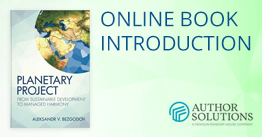CONCEPT OF SUSTAINABLE DEVELOPMENT
The Concept of Sustainable Development derives from a scientific and social-ideological study of the systemic civilization crisis and the world’s problems. The progressive part of the world’s scholarly community and political elites had recognized their existence by the end of the 20th century. They looked at the coming 21st century as an era of uncertainty and escalating global catastrophic processes.
The term was first used in the UN Program for Global Change to identify humanity’s development trajectories, which was adopted by the UN International Commission headed by former Norwegian Prime-Minister Gro Harlem Brundtland. It was used in the 1987 report "Our Common Future". The phrase sustainable development was used to denote the key idea reflecting the meaning and values of the global anti-crisis movement. The phrase sustainable development was used to denote the key idea reflecting the meaning and values of the global anti-crisis movement.
The institutionalisation of the sustainable development category took place at the United Nations Conference on Environment and Development (UNCED) in Rio de Janeiro in 1992. It was there that the Concept of Sustainable Development was made the foundation of anti-crisis environmental modelling.
The notion of sustainable development was first tied to the sphere of the relationship between man, society and nature. Sustainable development implies: normative-legal and other mechanisms of restraining human economic intervention in nature; other side effects of globalization based on scientific assessment and forecasts; and some other principles approved by global international institutions (e.g., the UN).
CONCEPT OF SUSTAINABLE DEVELOPMENT (Page II)
The goal of sustainable development as a modern civilization economic policy concept and strategy is to move humanity to the state of global dynamic balance and organic growth.
In the early 21st century it became part of the economic, sociological and political agenda as a global trend, and a fully-fledged domestic policy direction in a number of developed and developing countries (over a hundred states developed their own sustainable development strategies), as well as the international policy of global institutions.
Sustainable Development Concept Key Ideas:
- The 20th-century dominant economic growth model must be seriously adjusted by introducing environmental and social orientations, requirements and limitations.
- The sustainable development category makes sense only in relation to the entire humanity and nature: the task of sustainable development strategy formulation and implementation is posited both at the level of modern civilization as a whole, and an individual state in particular. Sustainable development must not only include an economic and environmental perspective but also a social one, because people tend to focus primarily on resolving pressing social problems.
- Environmental protection must constitute an integral part of human society’s life, and it cannot be treated in isolation from it. A comprehensive approach alone will ensure sustainable development as a worldwide strategy (it is futile to implement it at a lower level).
- Human poverty and the environment are not compatible. The more poor the population, the more harm there is to the environment.
- While environmental orientation is a priority for sustainable development, its main objective is to care for people, to achieve a high level of quality of life, and to ensure conditions for a healthy and productive life. Even more so, it is with this approach that the state of the environment is not disregarded, because a direct connection is established between the people’s level of life and the quality of the environment.
- It is important to note that sustainable development is not only defined as one that rationalizes economic growth, but also as one that distributes fairly its outcome, reviving the environment rather than destroying it, as well as enlarging people’s potential rather than reducing it.
- Human survival implies not only maintaining the life balance of the current human population, but also ensuring natural resource use conditions for future generations.
- Saving and protecting nature implies keeping and improving the health of the biosphere as a natural basis of life on the planet and ensuring its sustainable reproduction and further evolution.
- The active vector of the sustainable development strategy is aimed at creating such a biospheric system that could be capable of resolving globalization contradictions. Primarily, it has to do with the evolutionary-historical contradiction between: resource limitations and needs growth (nature and society); developed and developing countries (economic growth levels); rational economic development requirements and national interests (global and local).
- Achieving a strategic balance between human activity and consumption, and maintaining biosphere regenerative capacity, can be considered to be the most important sustainable development criterion on a world scale.
- Transition to sustainable development and following its course implies the environmentalizing of all production and consumption modes, as well as other drastic transformations of human activity, attitude and consciousness that have to proceed in a goal-oriented and systematic manner.
- Managing the transition to sustainable development implies decisive actions in uncertainty and risk conditions, because neither the slowing down of social-economic dynamics, nor stopping social-economic growth would resolve global problems or remove the threat of an environmental disaster.
- The sustainable development strategy can be implemented only if a new civilization model is introduced, which would require selection, re-orientation and transformation of several social processes. For example, it includes increasing the social status of education and science. These institutions play the leading role in sustainable development strategy implementation, because scientists are meant to form global public consciousness and define noospheric priorities.
- The comprehensive nature of sustainable development means that goals and objectives should be set as part of major human activity spheres such as economy, environment, the social sphere, state governence and governance, science, upbringing and education, security and defense, as well as international relations.
- Sustainable development is defined as a transitionary stage from the current crisis state of modern civilization to a future harmonized one. It is planned to resolve global problems and alleviate global risks by using such measures as: needs optimization; production structure, distribution and consumption transformation; as well as human consciousness evolution towards a rational-humanistic value system. It is expected that these measures will ensure a new worldview formation oriented at survival and improvement of the health of people and nature.
The concluding stage of sustainable development is the noosphere as the most desired and best state of humanity, when the environmentally acceptable impact of society on nature has been achieved as a result of human needs rationalization.
CONCEPT OF SUSTAINABLE DEVELOPMENT (Page III)
The radical differences between the Concept of Sustainable Development and the economic growth industrial paradigm is that it demands that modern civilization, with its production basis, replaces its expansive natural resource use with the need to accommodate the biosphere, observe its laws, and take into account its prohibitions and limitations.
The fundamental principles of sustainable development were outlined in the Declaration and other documents of the United Nations Conference on Environment and Development (Rio de Janeiro, 1992), the 19th Special Session of UN General Assembly (New York, 1997), and adapted in several national sustainable development strategies in later years. Their principles can be assessed using the following categories.
The anthropocentric principle: care of man, protection of his rights for a healthy and productive life in harmony with nature and society in an environment that is favorable for him. This principle defines world power co-operation in rooting out poverty, and standard of living and human need satisfaction disparities as the necessary sustainable development condition.
The comprehensive principle: the sustainable development model encompasses the interests of saving nature, social justice and care for the future.
The saving principle: human survival depends on the rate of transition to new economic activity methods and forms: resource saving, energy saving and health saving, which could be based on science-based technologies and implemented by the motivation of decision-makers.
The principle of the rational use of natural resources requires: harm-free management of renewable natural resources, efficient use of non-renewable ones, and their optimal consumption; finding alternative sources; timely waste disposal and safe burial.
The principle of prevention of going beyond the limits of ecosystem economic capacity concerns, in particular, limiting the use of economically unaffected parts of the planet’s landmass and the World Ocean.
The security principle requires carrying out safe economic activity and minimizing its social and environmental risks.
The prevention principle includes precautionary and preventive action in the event of serious and irreversible environmental danger, prevention of man-made disasters and emergency situations, carrying out health and safety measures, and preventing other global problems (the economic efficiency principle is consciously decentred in this case).
The sovereignty principle is one of the most content-extensive sustainable development principles. It encompasses three activity, process and relationship types. First, it establishes the right of states to define their national natural resource management policy, and exploration, in accordance with the policy, of the state’s resources. They are required by the international community to ensure the environmental safety of their activity vis-à-vis other countries. Second, it protects international trade against hidden restrictions and discrimination based on arbitrary environmental protection measures. Third, it forbids conscious “importing” of hazardous activity from one country to another.
The justice principle establishes equal development rights for current and future generations, and between all countries of the world without exception..
The synergy principle requires all countries to interact in the transition to sustainable development, and appropriate strategy implementation, in their economic, political-legal and social systems. It also implies the global unification of effort in learning about the world, global problems and their solutions. In particular, it talks about scientific-technical information, research findings and technology exchange, including innovations. This co-operation must acquire a global partnership character.
The captivity principle relates to environmental legislation regarding environmental standards, regulation principles, and environmental policy priorities, which must meet individual countries’ conditions, where they are adopted, including economic conditions.
The selective priority principle emphasizes the significance of developing countries’ current conditions and needs, especially for the least developed and environmentally vulnerable countries.
The responsibility principle: all countries of the world must carry responsibility for maintaining the Earth’s environmentally stable zones, its ecosystems and resource reproduction, as well as plants and animals. The liability for harming the environment in any way must be ensured both at the national legislation level and at the level of international law, with world powers co-operating in developing such legislation.
The environmental harm internalization principle talks about the necessity to find a possibility to re-distribute economic means to cover harmful environmental effects based on the premise that the polluter must cover such effects.
The optimization principle requires the discontinuation of unsustainable production and consumption models, as well as encouraging an appropriate demographic policy.
The openness principle guarantees public availability of environmental information at the national level for every individual, and at the international level for countries’ official representatives mandated to take environmental security and emergency situation decisions. Information rights must be endorsed by appropriate legislation.
The pacifism principle is based on the premise that wars and military conflicts have a destructive effect on sustainable development: peace is the most important and necessary condition for environmental protection and introducing a new, noospheric civilization model.
The ecological principle: environmental and nature-saving orientation and saving life on Earth must become a dominant feature of economic and educational policy, modernizing economic practices, social relations and public consciousness, and the core of environmentally conscious economic development.
The gradualism principle: transition to sustainable development must have an evolutionary character avoiding sudden leaps, coercion or any actions that could result in conflict or resistance at a regional or international level. The terms and rates of production-technical, economic-political, organisational-administrative or other social transformations must be goal-oriented co-ordinated relative to the time of the predicted global environmental catastrophe. The goal is to put off for at least several decades the environmental calamity to be able to complete the comprehensive environmentalization of economic and social practices as well as public consciousness. National transition strategies to sustainable development must be based on appropriate regional, infrastructural and social specifics. The more developed and resource-rich economies could act as leaders and senior partners in the environmentalisation and general improvement of less developed countries economically and socially. At the same time, it does not imply one-sided “donorship”, but rather full-scale co-operation so that all participants comply with international legal norms and provide genuine contributions to the process.
The voluntary principle: different states and nations interact on a global partnership and goodwill basis, which is also the source of international sustainable development law.
The above principles are reflected in the concretization of sustainable development directions, collectively worked out at the end of last century.
CONCEPT OF SUSTAINABLE DEVELOPMENT (Page IV)
The main sustainable development directions were proposed at the World Summit in Copenhagen on 6 - 12 March 1995:
- Wide civil society participation in developing and carrying out solutions, determining society functioning and well-being;
- Large-scale sustainable economic growth and sustainable development models, and demographic aspect integration into economic and development strategies, which accelerated sustainable development rates and rooting out poverty, and will contribute to achieving demographic goals and improving people’s quality of life;
- Just and non-discriminating distribution of benefits conditioned by the growth among social groups and countries, and expanding access to productive resources for destitute people;
- Interaction of market forces, encouraging effectiveness and social development;
- Government policy directed at overcoming factors leading to social antagonism and the respect for pluralism and diversity;
- A favorable and stable political and legal structure that contributes to mutual improvement of the connection between democracy, development, all human rights and the main freedoms;
- Political and social processes characterized by preventing isolation and complying with pluralism and diversity, including religious and cultural diversity;
- Strengthening the role of the family in the interests of social development, as well as the community and civil society roles, in accordance with the principles, goals and responsibilities proclaimed in the Declaration of the World Summit and at the International Conference on Population and Development;
- Increased access to knowledge, technology, education, healthcare and information;
- Strengthened solidarity, partnership and co-operation at all levels; as well as government policy that gives people the opportunity to lead healthy and productive lives;
- Protecting and saving the environment in the context of human-oriented sustainable development.
The Concept of Sustainable Development was the first to systematize a whole range of ideas originated between the 18th and 20th centuries, which have to do with the destiny of humanity influenced by the relationship “people – society – nature”. It has suggested an alternative economic growth model in the form of noosphere-oriented transitional type civilization. The Concept of Sustainable Development embodied an attempt to solve global problems by economic means using some integration processes.
The practical implementation of the strategy of sustainable development has run into difficulties whose analysis became the starting point of the Planetary Project.









